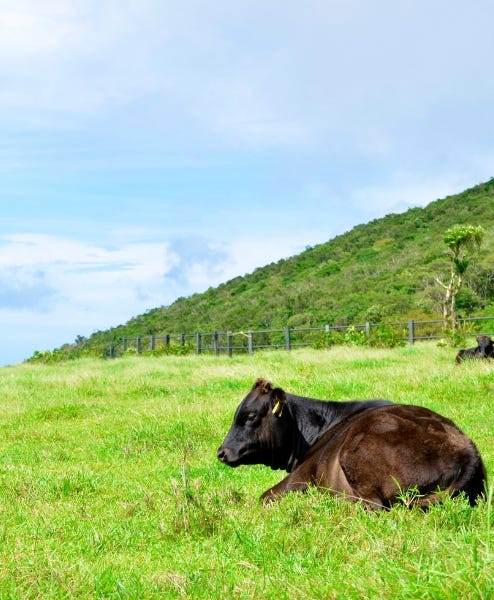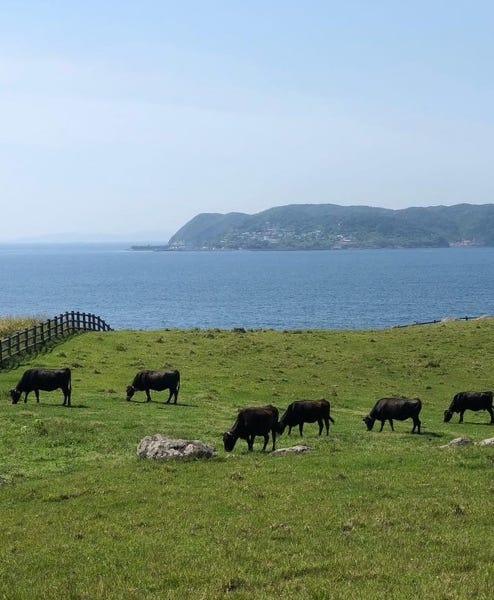Wagyu Breeding
WAGYU BEEF
Wagyu beef production: traditional techniques and innovations abroad
Wagyu beef has become very popular all over the world for its soft texture and unique, intense flavor. The origin of Wagyu meat dates back to Japan, where cattle farms are very old and the culture of animal husbandry is highly developed.
In fact, there are several Wagyu beef farms in Japan, but the most famous are located in the regions of Kobe, Miyazaki, and Hokkaido. Each region has its own particular breeding and feeding techniques, but in general Wagyu meat farming requires constant attention.
However, in recent years, Wagyu beef breeding has spread to other countries such as the United States, Australia, and Europe. In these countries, Wagyu cattle are raised following Japanese techniques, but with some variations. In Australia, Wagyu beef farming has developed greatly in recent years, becoming one of the largest producers of Wagyu meat outside Japan. In the United States, Wagyu beef production spread mainly to the Midwestern states and Texas in the 1990s and has since become increasingly popular. American Wagyu beef is produced mainly for the domestic market, but it is also exported to some countries in Asia.
In Europe, Wagyu beef production is still limited, but recent years have seen a growth in Wagy cattle breeding




Feeding cattle for the highest quality Wagyu beef
Wagyu beef is a delicacy derived from a particular breed of Japanese cattle. This meat is valued worldwide for its tenderness, intramuscular fat and unique and intense flavor. The diet of Wagyu cattle is one of the key components for the quality and texture of the meat. But what diet do Wagyu cattle follow?
Wagyu cattle farms in Japan follow specific nutrition and breeding techniques to ensure meat quality. The animals are fed a specific diet, which includes corn, rice, barley, fruits and vegetables, as well as other nutrients that improve their quality. In addition, the animals are brushed and massaged daily to improve their blood circulation and make the meat even softer. This type of feeding and animal care requires a great deal of commitment and constant attention.
In the United States, the feeding of Wagyu cattle is similar to that used in Japan, namely corn and barley, but also other grains. In Australia, the feeding of Wagyu cattle involves the use of hay, grains and other natural foods. The animals are fed a balanced diet, which is carefully monitored to ensure the right amount of protein, fat and carbohydrates. In addition, animals are moved to different pastures to ensure the quality of the grass they eat.
Wagyu cattle breeders follow strict rules to ensure that the animals grow healthy and strong to produce high-quality meat. The animals are kept in large, comfortable spaces where they can move freely and socialize with other members of the group. This type of farming not only ensures the health of the animals, but also improves the flavor and quality of the meat.


The history of Wagyu breeding in Japan
Wagyu cattle breeding in Japan has a long history dating back many centuries. The earliest traces of cattle breeding in Japan date back to the Yayoi period, between 300 B.C. and 300 A.D., when cattle were used for the field and transportation. However, it was only during the Edo period, between 1603 and 1867, that cattle breeding in Japan began to develop.
During the Edo period, cattle were still mainly used to work the land. However, as economic prosperity increased, the Japanese began to appreciate beef more and more. This led to an increase in demand for meat, which in turn prompted Japanese farmers to try to improve the quality of the meat they produced.
Initially, Japanese farmers crossed the local breed of cattle with other breeds from abroad, such as the British Shorthorn breed of cattle and the Chinese Kumamoto breed of cattle. These crosses resulted in some hybrid breeds, but the meat produced was still not considered high quality.
In 1868, with the end of the Edo period and the beginning of the Meiji era, Japanese farmers began experimenting with new breeding techniques to improve meat quality. In 1944, the Japanese government established the Wagyu meat evaluation system so as to ensure the quality of the meat produced. Over the years, the evaluation system has evolved, but the goal remains the same: to ensure the quality of Japanese Wagyu meat.
Wagyu meat was introduced to international markets in the 1990s and has since become a delicacy enjoyed by gourmets around the world. The spread of the Internet and social media has helped make Wagyu beef known worldwide, driving demand for the prized meat.


Different types of Wagyu breeds
Wagyu cattle breeds are native to Japan and have been selected over centuries to produce high quality meat. Some of the main breeds of Wagyu cattle are:
- Japanese Black: this is the most common breed of Wagyu cattle in Japan, with more than 90 percent of the animals in this breed. Japanese Black meat is characterized by the presence of intramuscular fat and soft, juicy texture. The marbling of Japanese Black meat is a unique and valuable characteristic, making it one of the most valued meats in the world. Japanese Black meat is dark in color and has an intense and deep flavor. This meat is used to prepare gourmet dishes.
- Japanese Brown: this breed of Wagyu cattle is native to the Kumamoto region of Japan. Japanese Brown meat has a good amount of intramuscular fat, but less than the Japanese Black breed. The texture of the meat is soft and juicy, with an intense flavor and a sweet note. This meat is especially popular in Japan, where it is used in the preparation of traditional dishes such as sukiyaki and shabu-shabu.
- Japanese Shorthorn: it is smaller than other breeds. Japanese Shorthorn meat has a unique and intense flavor and a soft texture. Japanese Shorthorn animals are medium-sized and have a whitish coloring with black tones. This breed of Wagyu cattle has been selected over centuries for the production of high-quality meat, and has long been used as a working animal in rice fields.
- Japanese Polled: this is a breed of Wagyu cattle native to the Tottori region of Japan. Japanese Polled animals are medium-sized and have a light brown coloration. This breed is often crossed with other Wagyu cattle breeds to improve meat quality and produce new varieties of Wagyu cattle.
- Australian Wagyu: the most common breed of Wagyu cattle in Australia, where the animals were imported from Japan in the 1990s. Most Wagyu cattle herds in Australia are located in the Margaret River region of Western Australia, where the climate and grass quality are particularly favorable for animal growth.
Discover the products
Longino & Cardenal
Longino & Cardenal stands today as one of Italy's leading "food globetrotters." With passion and courage it carries out a continuous search for the best raw materials, often little known to most, in order to meet the new trends in consumer behavior that seek excellent products proposed in innovative forms. Delivery of products is expected in 48/72 hours from the order if the product is already in stock. All our deliveries use specialized, refrigerated couriers.








